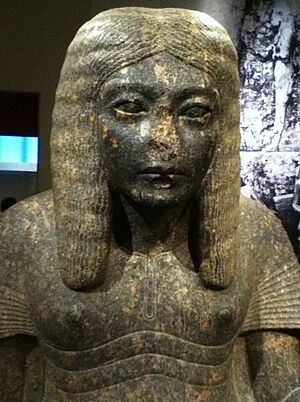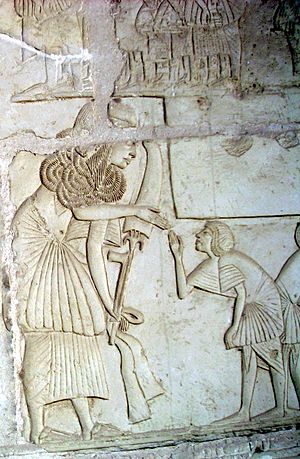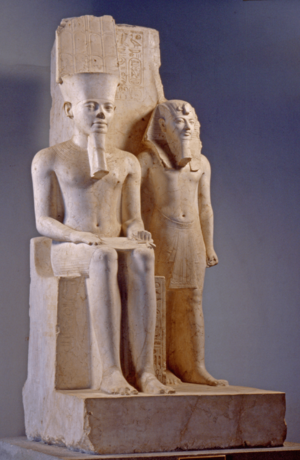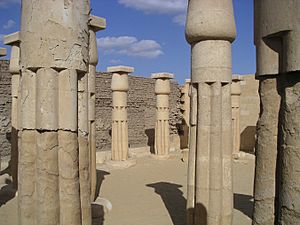Horemheb facts for kids
Quick facts for kids Horemheb |
|
|---|---|
| Horemhab, Haremhab, Haremheb | |
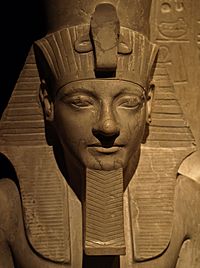
Detail of a statue of Horemheb, at the Kunsthistorisches Museum, Vienna
|
|
| Pharaoh | |
| Reign | 1319 BC or 1306 BC until 1292 BC (18th Dynasty) |
| Predecessor | Ay |
| Successor | Ramesses I |
| Consort | Amenia, Mutnedjmet |
| Died | 1292 BC |
| Burial | KV 57 |
| Monuments | Memphite Tomb Temple of Ay and Horemheb |
Horemheb (meaning "Horus is in Jubilation") was the last pharaoh of ancient Egypt's 18th Dynasty. He ruled for about 14 years, from 1319 BC to 1292 BC.
Before becoming pharaoh, Horemheb was a powerful general. He served under pharaohs Tutankhamun and Ay. He was not related to the royal family by birth. He became pharaoh through his military strength and leadership.
Horemheb helped bring stability back to Egypt. The country had faced problems during the Amarna Period. He worked to restore order and traditional religious practices. He also started to remove monuments of earlier rulers like Akhenaten. Horemheb had no sons who survived him. So, he chose his vizier, Paramesse, to be the next pharaoh. Paramesse later became Ramesses I.
Contents
Horemheb's Early Career
Horemheb likely came from a town called Hnes, near the Nile River. His family was not royal. He started his career as a "royal spokesman for foreign affairs." This meant he handled Egypt's relationships with other countries. He even led a trip to meet leaders in Nubia.
Horemheb quickly became important under Tutankhamun. He became the commander-in-chief of the army. He was also a trusted advisor to the young pharaoh. His tomb in Saqqara lists his many important titles. These include "Hereditary Prince" and "Chief Commander of the Army." The title "Hereditary Prince" showed he was seen as the rightful heir to the throne.
Becoming Pharaoh
When Tutankhamun died, the older vizier Ay became pharaoh instead of Horemheb. Horemheb was away with the army at that time. Tutankhamun's queen, Ankhesenamun, also refused to marry Horemheb. She did not want a commoner to become king.
After Ay ruled for about four years, Horemheb took power. He was able to do this because he was the army's commander. He removed Ay's chosen successor, Nakhtmin. Horemheb also damaged Ay's tomb and monuments. However, he protected Tutankhamun's tomb. This was likely because Tutankhamun had helped Horemheb rise to power.
Reforming Egypt
When Horemheb became pharaoh, he made many changes to Egypt. He wanted to fix problems from the Akhenaten's reign. He appointed new judges and local religious leaders. He divided legal power between Upper and Lower Egypt. This was done between the viziers of Thebes and Memphis.
These changes are written on a large stone tablet called The Great Edict of Horemheb. This tablet is at the Temple at Karnak. It shows how important Horemheb thought these reforms were.
Horemheb also improved the army. He reorganized the workers at Deir el-Medina. He brought back the priests of Amun. But he made sure the priests did not become too powerful. He appointed many priests from the army. This ensured their loyalty to him.
Building Projects
Horemheb was a busy builder. He built many temples and structures across Egypt. He constructed parts of the Great Hypostyle Hall at the Temple at Karnak. He used stones from Akhenaten's old monuments for his buildings. This helped restore the old order that existed before the Amarna period. He brought back the worship of ancient gods, especially Amun. This showed he was a true pharaoh who restored Maat (world order).
Horemheb's Reign Length
For a long time, historians debated how long Horemheb ruled. Some thought it was 27 years. However, new discoveries suggest he ruled for about 14 years and 1 month.
Archaeologists found many wine jar labels in Horemheb's tomb (KV57). These labels had dates on them. The highest year mentioned was year 14. This suggests he was buried in his 14th year as pharaoh. Also, his royal tomb was not fully finished. If he had ruled for much longer, it would likely have been completed. Most experts now agree on the 14-year reign.
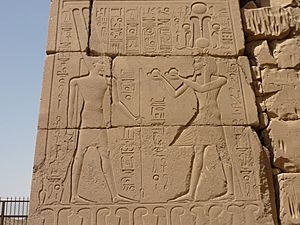
Names and Symbols
Horemheb's names show his connection to different gods. His throne name means 'Sacred are the manifestations of Ra'. His birth name means 'beloved of Amun'.
He used stones from Akhenaten's temple at Karnak for his own buildings. This helped preserve some of Akhenaten's carvings. Horemheb is shown in reliefs wearing official robes. Sometimes he holds symbols of a high official. After he became pharaoh, the royal cobra (uraeus) was added to his image.
An inscription on a statue of Horemheb and his wife says he was protected by Horus. It also says he was chosen by Amun. It mentions that he restored statues of old gods. He also rebuilt temples that were in bad condition. He even brought in military officers to serve as priests for the Amun cult.
Who Came After Horemheb?
Horemheb helped Egypt regain its strength after the Amarna period. This prepared the way for the next dynasty. The 19th Dynasty included powerful pharaohs like Seti I and Ramesses II.
Horemheb's second wife was Queen Mutnedjmet. She might have been Nefertiti's younger sister. They did not have any children who survived. Mutnedjmet's mummy shows she had given birth several times. She was buried with a baby, suggesting they died during childbirth. Horemheb had no children with his first wife, Amenia, who died before he became pharaoh.
Since Horemheb had no surviving son, he chose his vizier, Paramesse, to be his successor. Paramesse was loyal and had a son and grandson. This meant the royal family line would continue. Paramesse became pharaoh Ramesses I. He started the 19th Dynasty.
Horemheb's Tombs
Horemheb had two tombs built for himself. The first was in Saqqara, near Memphis. He built this when he was still a nobleman. After he became pharaoh, he built a royal tomb in the Valley of the Kings in Thebes. This tomb is known as KV 57.
His royal tomb was the first to feature scenes from the Book of Gates. This book described the journey of the sun god through the underworld. The tomb was excavated in the early 1900s. It was found in poor condition due to robbers and natural events. The lid of his sarcophagus had been broken by robbers.
Horemheb in Pop Culture
Horemheb has appeared in many movies, TV shows, and books.
Film
- In the 1954 movie The Egyptian, Horemheb was played by Victor Mature.
- Salah Zulfikar played Horemheb in the 1973 Mexican short film Nefertiti and Akhenaton.
Television
- British actor Nonso Anozie played Horemheb in the 2015 TV series Tut.
Music
- Horemhab is a character in the opera Akhnaten by Philip Glass.
Literature
- Horemheb is a main character in Nick Drake's mystery novels. These include The Book of the Dead and Tutankhamun.
- He is also a major character in P. C. Doherty's historical novels.
- Pauline Gedge's novel The Twelfth Transforming features Horemheb.
- He appears in Katie Hamstead's trilogy, Kiya: Hope of the Pharaoh.
- Horemheb is a key character in Kyah Merritt's trilogy A Legacy of Light.
- He is a minor character in Michelle Moran's novels Nefertiti and The Heretic Queen.
- Horemheb is a major character in Lynda Suzanne Robinson's Lord Meren series.
- He is a minor character in Chie Shinohara's Japanese graphic novel, Red River.
- Horemheb is a major character in Mika Waltari's 1945 book The Egyptian.
- He appears in two novels by Allen Drury.
- Horemheb is a key character in Judith Tarr's novel Pillar of Fire.
See also
 In Spanish: Horemheb para niños
In Spanish: Horemheb para niños


